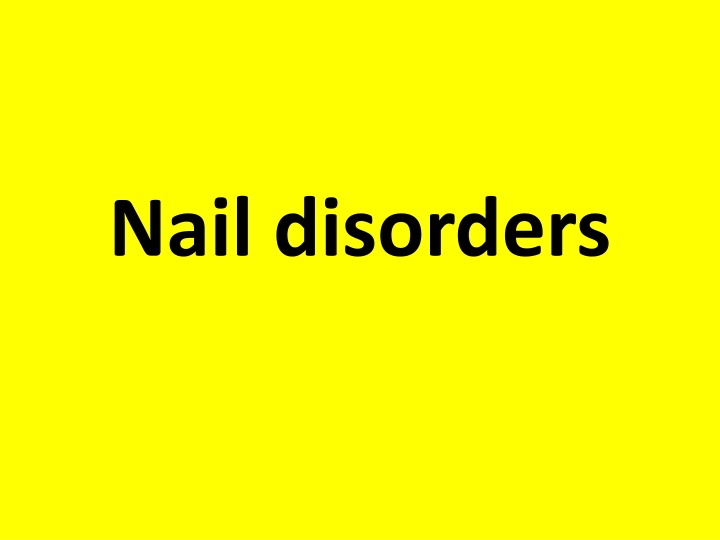
Nail Disorders
Explore common nail disorders including psoriasis, onycholysis, subungual hyperkeratosis, lichen planus, and nail infections like acute and chronic paronychia. Learn about symptoms, causes, and treatment options to maintain healthy nails.
Download Presentation

Please find below an Image/Link to download the presentation.
The content on the website is provided AS IS for your information and personal use only. It may not be sold, licensed, or shared on other websites without obtaining consent from the author. If you encounter any issues during the download, it is possible that the publisher has removed the file from their server.
You are allowed to download the files provided on this website for personal or commercial use, subject to the condition that they are used lawfully. All files are the property of their respective owners.
The content on the website is provided AS IS for your information and personal use only. It may not be sold, licensed, or shared on other websites without obtaining consent from the author.
E N D
Presentation Transcript
Nail changes in skin diseases 1- psoriasis: 10-50% of psoriasis have nail involvement A- pitting : ice-pick depressions in nail plate other causes: normal finding alopecia areata B- onycholysis: separation of nail plate from its bed other causes:-skin diseases: fungal infection, eczema
- general medical diseases: hypo & hyperthyroidism - trauma: house wives - drugs: tetracyclin, PUVA- therapy C- subungual hyperkeratosis: thickening of nail bed, distorted & separated nail plate
2-Lichen planus: 10% have nail changes a- thinning of nail plate & longitudinal ridging b- pterygium: adhesion & fusion of proximal nail fold with nail bed due to destruction of nail matrix
Nail infections 1- acute paronychia: Sudden painful red swelling of nail fold with accummlation of pus behind cuticle, usually due to staphylococci, but other bacteria like strepto. pseudomonas, G-ve bacteria may be involved. Treat: drain pus + topical & systemic antibiotics
2- chronic paronychia: Common in house wives, insidious mild pain & swelling of nail folds, mostly due to candidal infection. Acute exacerbation may occur due to secondary bacterial infection. Patho: on repeated exposure of the fingers to moisture the cuticle is lost leaving space between proximal nail fold & nail plate which is easily contaminated with Candida.
The nail folds are red , swollen & tender, the cuticle is absent , nail plate are deformed & thickened. Treat: keep fingers dry, wear cotton gloves under rubber glove . topical antifungal lotion, systemic antifungal ( fluconazole 150-300mg/wk)
2- Dermatophyte infection( onychomycosis) Tinea unguun 3-Viral infection: a- wart: periungual, common in children& nail bitters, it may involve nail folds or finger tips b- Herpetic whitlow: herpes simplex infection of finger tips, painful grouped vesicles( honey comb appearance.
Ingrowing toe nail Common , big toe is most ferquently affected The nail plate pierces lateral nail folds & entering dermis causing pain & swelling of nail folds, secondary bact infection may occur lead to pus formation & over growth of granulation tissue. Lateral pressure by tight shoes with excessive cutting of lateral part of nail plate are predisposing factors. Treat:cutting & removal of pentrant part of nail destruction of lateral part of nail matrix with phenol 80% application
Nail changes in systemic diseases 1- Beau s lines: Transverse depression of nail plates, it seen few weeks after stressful conditions such as fever, measles, pneumonia,DM..etc. The lines progress distally with normal growth of nail
2- clubbing of fingers: distal phalanges are enlarged,bulbous in shape, Nail plate is curved, obliteration of the angle made by proximal nail fold &nail plates. It is irreversable, associated with ch lung diseases, CV diseases, cirrhosis, thyroid diseases, colitis & may be seen in normal peoples
3- Terry s nail: the nails are white at proximal 2 thirds & normal pink distal third of nail beds. It is found in ch renal failure, congestive heart failure, DM, ageing. Half & half nail : proximal white half & distal pink half, seen in ch renal failure
3- spoon nail (koilonychia): central depression of nail plates with elevation of lateral parts ( spoon shape ). , reversable seen in normal children, iron deficiency anemia, Hemachromatosis
5- yellow nail syndrome: nail slow to grow or even stop to grow, nail plate thickened & become dark yellow, the cuticle & lunulae are lost . Associated with ch lymphodema of limbs, pleural effusion, bronchiectasis, ch bronchitis
